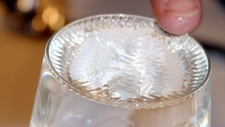Sound Energy

TEKS Objective
Students will identify and discuss how different forms of energy such as light, heat, and sound are important to everyday life.
Essential Understanding
The student knows that energy, force, and motion are related and are a part of their everyday life.
Science Background
Changing Sounds: BBC Learning (website) - Basic information about properties of sound, including pitch and loudness.
Changing Sounds
BBC Learning, www.bbc.co.uk
A Sound Education: K8 Science (video) - Dr. Greg Vogt explains the science of sound as a form of energy and discusses hearing, soundwaves, and common misconceptions about sound.
Signature Lesson
Sound Garden: PBS (website) - Students make a “sound garden” to compare and contrast the sounds made by different materials.
The Senses Teacher's Guide: Baylor College of Medicine (pdf) - Students explore how their brain and senses help them understand their surroundings. Download guide and use activity 5 - Hearing and the Senses with accompanying power point
The Senses Teacher's Guide
Baylor College of Medicine, www.bioedonline.org
- Supporting Lessons
- Extensions
- Assessment Ideas
- Literature Connections
- Related
TEKS - Additional Resources
Supporting Lessons
Sound is Vibration, Five Senses: SEDL (PDF) - Part of a comprehensive unit on the senses, designed specifically for kindergarten, this lesson focuses on sound energy.
Elaboration Lessons and Extensions
Super Sounding Drum: PBS Kids (PDF) - Make drums using different types of containers.
Assessment Ideas
Have students use a tuning fork or a metal triangle to experience, and then verbally explain, how sound is produced through vibration.
Literature Connections
All About Sound. Trumbauer, Lisa. (ISBN-13: 9780516258478)
Sounds All Around. Pfeffer, Wendy (ISBN-13: 9780064451772)
Vibrations. Schaefer, Lola M. (ISBN-13: 9780736803991)
Additional Resources
Exploring Sound: K8Science (PDF) - Students rotate through stations for each activity below and record what they learn about sound at each station in their science notebooks.
TEKS Navigation
Grade 1
Need Assistance?
If you need help or have a question please use the links below to help resolve your problem.

Comments